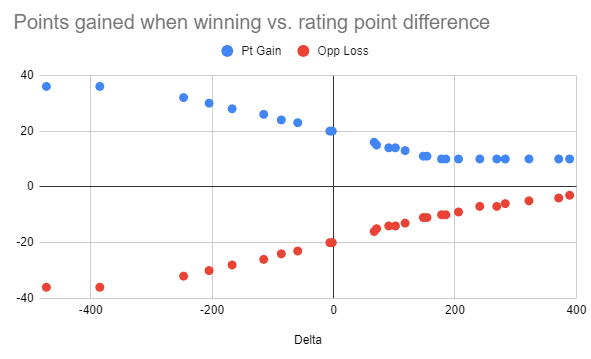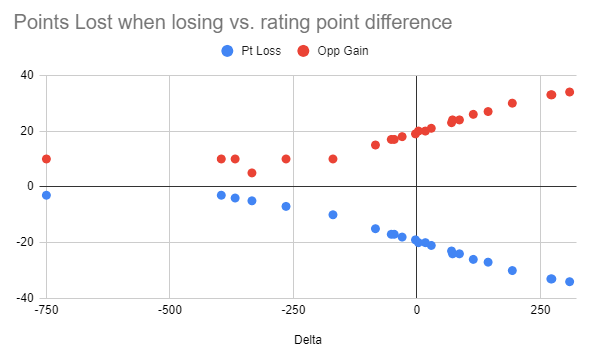Splinterlands Game Mechanics Series #1: Unwrapping the Rating Point System

Starting out a new series here that is hopefully informative to everyone about some of the lesser known game mechanics out there. Today's topic to get things started is the rating system.
What is a rating system?
A rating system is used in multi-player games in order to appropriately discern a player's relative skill level. This is accomplished by creating a numerical value that scales in accordance with the relative likelihood of a victory. Win against tougher opponents, you gain more points. Lose against weaker opponents, lose more points. The intent is to effectively sort the relative ranking of the players by skill level such that two players with the same skill level would effectively have a 50/50 win/loss rate. In most games, these rating systems are all modified versions of the traditional ELO rating sytem, invented for chess by Professor Arpad Elo.
What type of Rating System does Splinterlands Use?
Like many games, Splinterlands utilizes a modified ELO system. Winning against stronger opponents yields more rating points per win, and losing against someone much lower than you in rating will cause a significant points loss. However, unlike the true ELO system, the system used by Splinterlands is not a zero-sum system.
Definitions of terms used in this section:
Delta: The difference between your rating and your opponent's rating. A positive value means you are higher rated than your opponent. A negative value indicates you are at a lower rank than your opponent.
Pt Gain: Number of rating points earned when you win a match
Pt Loss: Number of rating points decrease when losing a match
Win Streak : A critical game mechanic that will double the amount of rating points earned for a win. Triggered by 3 consecutive wins. Will continue until a loss/draw.
What Happens When I Win?

The baseline for the battle is 20 points. If you and your opponent are identical rating, then the winner will gain +20 points and the loser will get -20 points.
Example 1:
Both you and opponent are at 1000 rating. After the match, you are the winner and gain 20 points and climb to 1020 points, conversely, your opponent will lose equal points and be at 980 points.
These point values are linear between -200 and +200 rating points, from +30 to +10 points per win.
Expressed mathematically, this would be:
Points gained per win = (-0.05 * delta) + 20
Example 2:
If you and the same opponent play again, this time there is a 40 point delta between you and your opponent (1020 vs. 980, see Example 1)
If you were to win again, instead of gaining 20 points, you will only gain 18 points this time. (-0.05 * 40 = 18). In this case, you would end up at 1038 and the opponent at 962.
But what about when the point difference is more than 200?
In the previous section, note that the linear model only works for +200 to -200 rating difference. This is because of some special mechanics built into the rating system. When you are significantly higher rated than your opponent >200 points and win a battle, they actually give you bonus rating points for winning (introducing inflation into the rating system). Each win when you are > +200 over your opponent gives a flat +10 rating points.
Rating Inflation
| Delta | Expected | Actual | Inflation |
|---|---|---|---|
| 200 | 10 | 10 | 0 |
| 240 | 8 | 10 | 2 |
| 300 | 5 | 10 | 5 |
| 360 | 2 | 10 | 8 |
| 399 | 0 | 10 | 10 |
So for each win against what is expected to be a significantly favored opponent, the system will generate some extra rating points out of nowhere to award you to help climb. This system was generated because there are reward tiers each season and ratings are reset each season. Without these bumps, it makes it very difficult for players to gain much separation given the short nature of the season. The dev team has implemented some anti-camping mechanisms for this as well to prevent players from camping in a lower league to farm rating points from players below them with minimal risk (this is not covered in this post)
On the flipside, what happens when you were considered the significant underdog? The devs have decided to place a cap on this side as well (most likely due to there being a cap on "skill" so enforcing harsh penalties for losses which are outside of the bounds of pure skill difference is ultra punishing). That is, the losses are capped at +36 per win, which occurs when you are roughly -320 points relative to your opponent [ed: the exact number is not confirmed as I don't quite have enough data to say for 100% certainty]. No matter how much lower rated you are than this, you can only gain 36 points and your opponent can only lose 36 points.
What Happens When I Lose?

For losses, between +200 and -200 point delta, there is obviously no difference between a win or loss. However, once you get in those edge cases, once again we have unique behaviors observed. If you lose a match when you are >200 point favorite, then you will be punished up to 36 points. Once again, the exact value where it is capped at +36 is unknown as I haven't collected enough data to verify.
Where it gets more interesting is in the losses where you are significantly unfavored (<-200 points). Here, the losses are capped at -3 pts for a loss, so you will technically lose more points than you theoretically should, but this in in place to help curb the rating inflation mentioned in the previous section.
Win Streaks
Finally, it is important to mention win streaks. These are a special mechanic built into the system that are used as a booster to help normalize your rating as quickly as possible. The game figures that if you are winning against multiple opponents in a row, you are probably mis-rated (underrated) and will give you bonus points to attempt to set you to the correct rating as soon as possible. The criteria to trigger this mechanic is 3 wins in a row. Once you trigger the win streak, all rating point gains are doubled (your opponent's point loss is not affected). This doubled rating point gain will last until you draw or lose to an opponent.
Conclusion
The long and short of this is that Splinterlands employs a modified ELO system where the game attempts to sort you into a rating that is indicative of your relative strength. Below is a short summary of how the rating system operates:
You will gain / lose points with a base of 20. The adjustments are 1 rating point per 20 points of difference in your rating.
For heavily favored matchups (>200 pt difference), you gain +10 points for each win
For heavily unfavored matchups (<-200 pt difference), you can gain a maximum of +36 for each win
Win Streaks will double all rating point gains for you (no effect on the loser)
Losses are capped at a minimum of -3 points and a maximum of -36 points.
If you like this series, please leave a comment and suggest what other topics you might be interested in learning more about!
Next up in Understanding Game Mechanics Series: Strategies for Maximizing Rating Point Gain
Your post has been manually curated by @monster-curator Team!
Get instant cashback for every cards purchase on MonsterMarket.io. MonsterMarket shares 60% of the revenue generated, no minimum spending is required. Join MonsterMarket Discord.
@tipu curate
Upvoted 👌 (Mana: 67/87) Liquid rewards.
Congratulations @rooo! You have completed the following achievement on the Hive blockchain and have been rewarded with new badge(s) :
Your next target is to reach 800 upvotes.
You can view your badges on your board and compare yourself to others in the Ranking
If you no longer want to receive notifications, reply to this comment with the word
STOPCheck out the last post from @hivebuzz:
Support the HiveBuzz project. Vote for our proposal!
Thanks for sharing! - @marianaemilia
